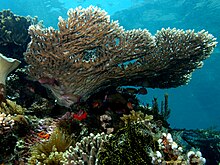Hexacorallia
| Hexacorallia | |
|---|---|

| |
| A stony coral, Acropora latistella | |
| Scientific classification | |
| Domain: | Eukaryota |
| Kingdom: | Animalia |
| Phylum: | Cnidaria |
| Subphylum: | Anthozoa |
| Class: | Hexacorallia |


Hexacorallia is a subclass of Anthozoa comprising approximately 4,300 species of aquatic organisms formed of colonial polyps generally with 6-fold symmetry. This includes all of the stony corals, which are vital for coral reef formation, as well as all sea anemones, tube anemones, and zoanthids, ranged within six extant orders.[1] The hexacorallia are distinguished from the other subclass of Anthozoa, Octocorallia, in having six or fewer axes of symmetry in their body structure and only single rows[citation needed] of tentacles. These organisms are formed of individual soft polyps which in some species live in colonies and can secrete a calcite skeleton. As with all Cnidarians, these organisms have a complex life cycle including a motile planktonic phase and a later characteristic sessile phase. Hexacorallia also include the significant extinct orders of the rugose corals and tabulate corals
Phylogeny
Hexacorallia is considered to be monophyletic, that is all contained species are descended from a common ancestor, however it has been suggested that many of the current orders are not. Historically Ceriantharia and Antipatharia were considered to be a separate subclass called Ceriantipatharia, though more recent genetic studies place them in Hexacorallia with Ceriantharia as the oldest, or basal, group.[1]
The subclass includes important coral reef builders the stony corals (Scleractinia), sea anemones (Actiniaria) and related tube-dwelling anemones (Ceriantharia), and zoanthids (Zoantharia). Antipatharia contains the black corals and Corallimorpharia are similar to anemones. The extant orders are shown below:[1]
| Hexacorallia | |
The anemone-like Relicanthus daphneae was classified as incerti ordinis within this class in May 2014.
A number of extinct orders of corals have been classified as their calcium skeleton forms a prolific fossil record. These are generally thought to be close to the ancestors of modern Scleractinians and existed during the Paleozoic Era 541-242 million years ago:[2][3]
- Numidiaphyllida †
- Kilbuchophyllida †
- Heterocorallia †
- Rugosa †
- Heliolitida †
- Tabulata †
- Cothoniida †
- Tabuloconida †
References
- ^ a b c Daly, M. (2007-07-21). "The phylum Cnidaria: A review of phylogenetic patterns and diversity 300 years after Linnaeus" (PDF). Zootaxa. 1668: 1–766. ISSN 1175-5326.
{{cite journal}}: Unknown parameter|coauthors=ignored (|author=suggested) (help) - ^
Oliver, W. A., Jr. (1996). "Origins and relationships of Paleozoic coral groups and the origin of the Scleractinia". In G. D. J. Stanley (ed.) (ed.). Paleobiology and Biology of Corals. Columbus, Ohio: The Paleontological Society. pp. 107–134.
{{cite book}}:|editor=has generic name (help)CS1 maint: multiple names: authors list (link) - ^ Ben Kotrc (2005). "Anthozoa: Subgroups". Fossil Groups. University of Bristol. Retrieved 2009-03-23.

